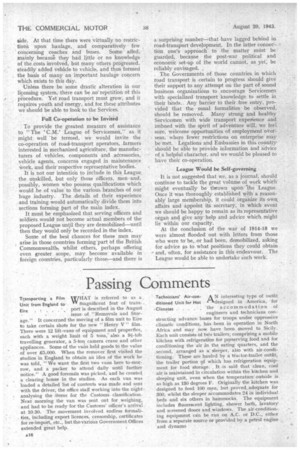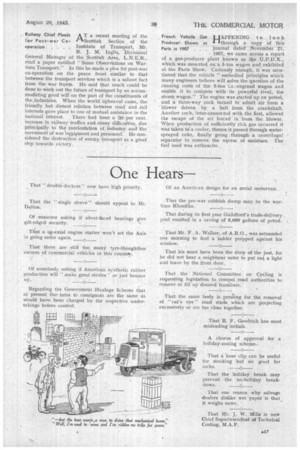Passing Comments
Page 18

Page 19

If you've noticed an error in this article please click here to report it so we can fix it.
Transporting a Film Unit from England to Eire
WHAT is referred to as a. " Magnificent feat of transport is described in the 'August issue of "Removals and Storage." It concerned the moving of a film unit to Eire to take certain shots for the new "Henry V" film. There 'were 12 lift .vans of equipment and properties, each with a weight limit of 5 tons,' also a 94-toil travelling generator, a 5-to9 camera crane and other appliances. Some of the vans held goods to the value of over £5,000. When the remover first visited the studios in England to obtain an idea of the work he was told, "We want the first two vans here to-morrow, and a packer to attend daily until further notice." A good foremaTn was picked, and he created: a 'clearing house in the studios. As each van was loaded a detailed list of contents was made and sent with the driver, the office stall working into the night:analysing the -items for the Customs classification. Next morning the van was sent out for ,weighing, and had to be ready for the Customs' officer's arrival at 10.30. The movement involved endless formalities, including export licences, censorship, certificates for re-import, etc., but the'varinus Government Offices extended great help.
Technicians' Air-conA N interesting type of outfit ditioned Unit for Hot i'designed in America, for
'Climates the accommodation of.
engineers and technicians constructing advance bases for troops under oppressive climatic 'conditions, has .been in operation in North . Africa and may now. have been moved to Sicily. Each unit consists of two trailers, comprising a mobile kitchen with refrigeratiOn for preserving food and for conditioning the air in the eating quarters, and the .second, arranged as asleeper, also with air-conditioning. These are hauled by a tractor-trailer .outfit, the trailer portion 9f which has refrigeration equipment for food storage. . It is said that clean,' cool ' air is maintained in circulation within the 'kitchen and sleeping unit, even when the temperature outside is as .high as 130 degrees F. Originally the kitchen was designed to feed 100 rnen, but proved, adequate for 300, whilst the sleeper accommodates 24 in individual beds and six others in hammocks. The equipment includes fluorescent lighting, shower bath, lavatory and screened doors and windows. The air-conditioning equipment can be run on A.C. or .D.C.," either 'from a separate source or 'provided by a petrol engine 'and dynamo
Railway Chief Pleads for Post-war Co operation
AT a recent meeting of the Scottish Section . of the Institute of Transport, Mr. R. J. M. Inglis, Divisional General Manager of. the Scottish Area, L.N.E.R„ read a paper entitled " Some Observbtions on Wartime Transport." In this he made a plea for post-war co-operation on the peace front similar to that between the transport services which is a salient fact from the war fronts. He said that much could be done to Work out the future of transport by an accommodating good will on the part of the constituents of the.industries. When the world upheaval came, the friendly but distant relation between road and rail interests gave place to one of mutual. assistance in the
national interest. There had been a 50 per cent. increase in railway traffics and Many difficulties, due principally to the reorientation of industry and the movement of wareqvipment and personnel. He considered the destruction of enemy transport as a great step towards victory.
HAPPENLNG to look 'through a copy of this journal dated November 21, 1907, we came across a report of a gas-producer plant known as the U.P.D.X., which was mounted on a 5-ton wagon and exhibited at the Paris Show. Curiously enough, it was mentioned that the vehicle " embodied principles which many engineers believe will solve the question of the running costs of the 5-ton Lc.-engined wagon and enable it to compete with its powerful rival, the steam wagon." The engine was started-up on petrol, and a three-way cock turned to admit air from a blower driven by a belt from the crankshaft. Another cock; inter-connected with the first, allowed the escape of the air forced in from the blower. When production of sufficiently rich gas occurred it was taken -US a cooler, thence it passed through watersprayed coke, finally going through a centrifugal separator to remove the excess of moisture. The fuel used was anthracite.
French Vehicle Gas Producer Shown at Paris in 1907 .




















































